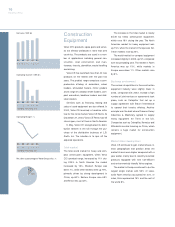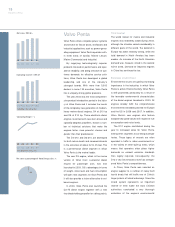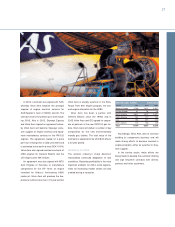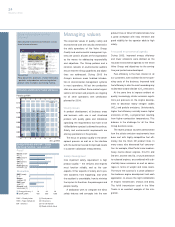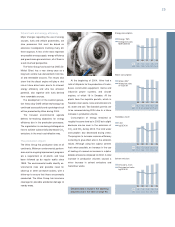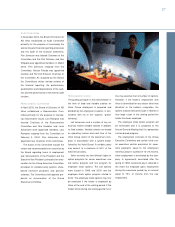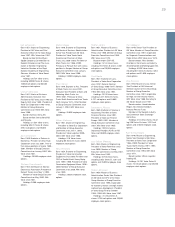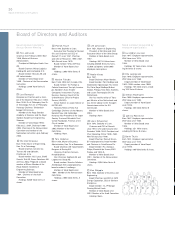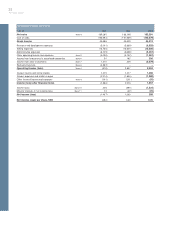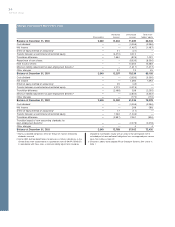Volvo 2003 Annual Report Download - page 26
Download and view the complete annual report
Please find page 26 of the 2003 Volvo annual report below. You can navigate through the pages in the report by either clicking on the pages listed below, or by using the keyword search tool below to find specific information within the annual report.
24
Business Areas
Managing values
The corporate values of quality, safety and
environmental care are naturally immersed in
the daily operations of the Volvo Group.
Quality and environmental management sys-
tems are used in all parts of the organization
as the means for addressing responsibility
and objectives. The Group policies and a
common network of environmental auditors
ensure that the Group guidelines and objec-
tives are addressed. During 2003 the
Group’s business areas finalized introduc-
tion of environmental management systems
in most operations. All but two production
sites are now certified. Some market organi-
sations still remain and projects are ongoing
for all other operations with certification
planned for 2004.
Quality issues
In product development, all business areas
and business units use a well structured
process with quality gates and milestones
specifying the requirements that have to be
fulfilled before a project is allowed to continue.
Safety and environmental requirements are
also key parameters in the process.
The focus on product quality in the devel-
opment process as well as in the interface
with the customer has led to improved results
in customer satisfaction measurements.
Safety development
One important safety requirement is high
product quality – the vehicles and engines
must function reliably, and as the user
expects. Other aspects of safety are to pre-
vent accidents from happening, and when
the accident is unavoidable, how to minimize
the injuries for the driver, the passengers and
people nearby.
A dedicated work to integrate the Volvo
safety features and concepts into the new
product lines at Volvo CE demonstrates how
a good workplace with easy entrance and
good visibility for the operator adds to high
safety.
A focused environmental agenda
During 2002, improved energy efficiency
and lower emissions were defined as the
focused environmental agenda for the entire
Volvo Group, and objectives for the coming
tree-year period were developed.
Fuel efficiency is the main interest of all
our customers, with its direct link to the oper-
ating costs of the business. Improved total
fuel efficiency is also the most rewarding way
to decrease carbon dioxide (CO2) emissions.
At the same time to improve ambient air
quality, increasingly stricter emission regula-
tions put pressure on the engine develop-
ment to decrease mainly nitrogen oxides
(NOx) and particle emissions. Unfortunately,
higher fuel efficiency normally means higher
emissions of NOx, a physical fact resulting
from higher combustion temperatures. This
balance is the challenge for all the Volvo
Group business areas.
The recent product launches demonstrate
how the stricter emission requirements have
been met with highly competitive fuel effi-
ciency, like the Volvo CE product lines. In
many cases also decreased fuel consump-
tion, for example, Volvo Penta’s new medium-
heavy marine diesel engines, D4-210 and
D6-310, and the new D3, a future alternative
to outboard engines, are combined with sub-
stantially lower emissions as well as advan-
tages in terms of weight and noise levels.
The key to the success is a close collabora-
tion between engine development and each
application, to ensure the right combination
of engine, transmission, chassis and body.
The I-shift transmission used in the Volvo
Trucks is an excellent example of this inte-
gration.
M ore inform ation on the
Internet
More detailed environmental information can be
found at www.volvo.com.
You will find:
Policy documents, brochures, environmental data
- products and production, emission legislation,
product safety examples and training material.
0.16
0.14
0.12
0.10
0.08
0.06
0.04
0.02
0.00012345678
Particles g/ KWh
NOx g/ KWh
US ´02 Euro 3
Current
Euro 4Euro 5
US 07-11
Euro 2
Emissions standards for trucks and buses
Fossil
Renewable
Diesel (crude
oil) [1]
DME (natural
gas) [1]
CNG (natural
gas) [2]
Hydrogen (EU
mix electr.) [3]
DME (wood)
[1,4]
Biogas
(sewage) [2]
RME (rape
seed) [1]
Ethanol (culti-
vated crop) [2]
Energy efficency, % 10 20 30
GW P g/kWh 400 600 1200
Energy efficency and GWP – Global
Warming Potential, “well-to-wheel”
DME = Dimethyl ether
RME = Rape methylester
BM = Biomass
[1] Diesel process
[2] Otto process
[3] Fuel cell hybride
[4] Wood via black liquor




